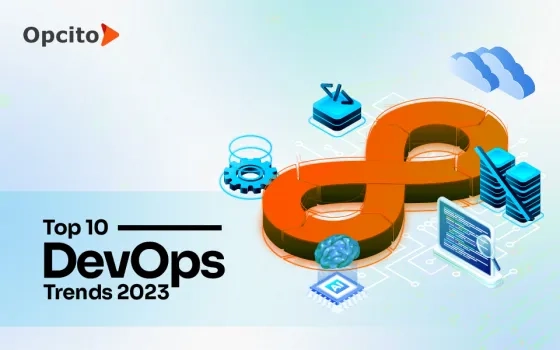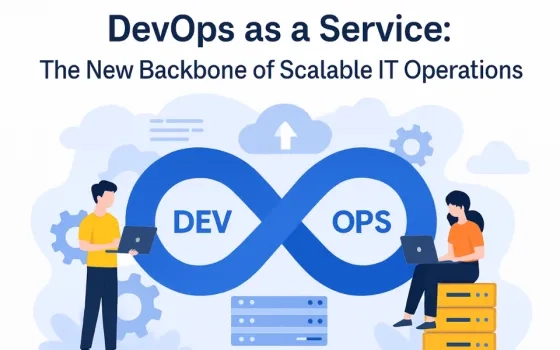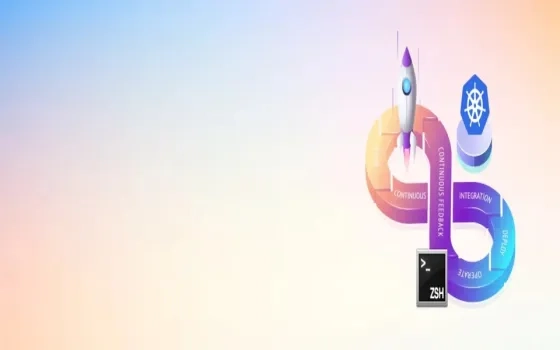A desire for faster feature additions and software delivery alongside better collaboration between developers and the system operators started the DevOps revolution. DevOps for organizations signifies a shift in their IT culture to be future-ready by adopting agile and lean methods to speed up the delivery of their IT services. A recent research study found that the Global DevOps Market size in 2021, which accounted for $ 7,398 Million, is projected to reach $ 37,227 Million by 2030, with a considerable CAGR of 20% during the forecast timeframe of 2022 - 2030. Along with placing a strong emphasis on people (and culture), DevOps also aims to enhance communication between the development and operations teams by breaking silos. But its implementation relies heavily on technology, particularly automation technologies and newer trends. In that context, every DevOps aficionado should keep an eye on emerging DevOps trends to ensure improved software delivery speeds and operational efficiency. This blog explores the future of DevOps in 2023 by looking at TEN key trends that will shape the DevOps environment of the future.
-
Microservices
The IT industry today makes widespread use of microservice-based architectures. Designed to accommodate the most recent DevOps trends, microservices have successfully broken down old, humongous monolithic systems into smaller, easier-to-manage bits and successfully streamlined operations, deployment, testing, and development. Additionally, it has streamlined the regular and constant delivery of applications and software. Facilitating DevOps methods and principles to enhance software quality has become more accessible and straightforward for development teams. Microservice architectures achieve greater agility and manageability across the software development life cycle. Microservices will become a leading force in the future. They will enhance organizational competitiveness as smaller software components can be developed by separate teams, speeding up the software development life cycle and allowing businesses to offer updates and apps more quickly.
-
Serverless
Serverless has been a buzzword in the DevOps space for some time and is bound to pick up more interest in 2023 and beyond. Serverless computing has enabled multiple organizations to outsource their infrastructure handling tasks to external experts, transforming their operations. This leaves room for developers to focus on building customer-centric applications without having to focus efforts on managing and maintaining servers, thus minimizing the risk of pipeline management problems. Organizations have recognized the advantages serverless provides, and many have already adopted a serverless strategy. The added operability helps bridge the gap between Dev and Ops with added benefits such as minimal to no server management, cost reduction (since users pay only for what they use), high scalability, quick deployment, more time to focus on UX, improved latency, and high efficiency. You can expect the serverless market to grow in 2023 as more organizations embrace it.
-
Infrastructure as Code
Infrastructure as Code (IaC) is set to be another leading DevOps trend in 2023 because it uses coding and automation to clear the way for smoother infrastructure provisioning and management. DevOps best practices require continuous monitoring, version control, and virtualization testing of the application code. IaC saves on manual effort for these activities, making it an efficient approach. Infrastructure as code paves the way for better and closer collaboration between software development and infrastructure teams. With increasing infrastructure needs and a need for being agile and fast, IaC will definitely pick up pace in 2023.
-
Multi-cloud Environments
Cloud and DevOps go hand in hand. The combination is highly beneficial for boosting productivity as it adds value and more features to the product pipeline. A multi-cloud system approach is proving instrumental, especially for organizations that want the absolute best in class from any provider. Another reason organizations adopt the multi-cloud approach is to support data, applications, and service availability. An increasing number of organizations want a combination of services from a mix of vendors. A multi-cloud environment is often beneficial to ensure High Availability. Multi-cloud architectures also allow selecting the cloud services with the optimal performance or cost for specific use cases. DevOps aims at efficiency and speed, and adopting a multi-cloud approach is one strategy that has shown signs of boosting both. It won't be a surprise to see a surge in multi-cloud adoption in 2023.
-
Low-code Applications
DevOps aims to shorten the application development lifecycle, and low-code platforms are excellent tools for time-saving and reducing complexity. The availability of drag-and-drop elements instead of having to write complex code has given 'citizen developers' (non-technical professionals) the chance to develop and deploy applications quickly. Professional developers also incline toward low-code applications to a certain level when the delivery deadlines are tight. Low code using reusable tested components can help reduce the number of bugs in an application, helping organizations develop an edge in a high-demanding, fast-moving marketplace. Expect to see more ready-made solutions and low to no-code applications for frequently used functionalities from many providers in 2023.
-
GitOps
GitOps could be called an evolution of infrastructure-as-code and is one of the most radical DevOps trends and best practices to be incorporated into a DevOps workflow. Organizations looking to improve infrastructure control, monitor better, and introduce application development automation can benefit from adopting GitOps. GitOps enhances version control, CI/CD tools, collaboration, etc., with efficiency; thus, its use is on the rise. Developer and IT teams have felt its benefits and now use Git to manage infrastructure and deploy applications effectively. We'll see it being extensively used because it shows great promise in decreasing the time between new releases, ensuring continuous delivery, and boosting the overall efficiency of the development process.
-
Machine Learning
Until recently, machine learning was considered synonymous with repeating human capabilities. However, it has evolved to be more than that in recent history. MLOps is a tailored subset of DevOps geared toward leveraging Machine Learning to improve operations. DevOps processes need optimization to achieve high quality and rapid release, and MLOps and AIOps play critical roles in this process. ML algorithms play crucial roles in analyzing development, operational, and test tools to find gaps, efficient management of alerts, and avoiding manual provisioning and efficient workflow integration. All of these result in increased synchronization and speed for product development pipelines. No wonder we have seen more involvement of ML tools in the DevOps pipelines, which will be on the up in the new year.
-
Artificial Intelligence
Artificial Intelligence adoption and exploring its full potential has been limited until recent breakthroughs in LLM (Chat-GPT) and image generation (Mid-Journey and Stable Diffusion). However, the future is shaping to become AI-driven, and DevOps is no exception. The use of AI in DevOps is maturing and has boosted its functionality to a great extent. Artificial Intelligence is already replacing certain human aspects and revolutionizing how organizations develop, deploy, manage, and deliver applications, especially where enormous amounts of data ingestion and computation is needed. Organizations are increasingly adopting AI for most stages of a typical SDLC, like testing, coding, releasing, and monitoring applications and are reaping benefits like achieving high data accessibility, workflow optimization, agile implementation, improved system monitoring, and augmented security. These proven benefits have seen more organizations turn towards AI for improved automation, quicker issue resolution, better collaboration, higher productivity, and gaining an overall competitive advantage in the market. Today's AI-powered DevOps tools come with advanced functionalities and play a crucial role in rightsizing workload configurations automatically. Their advancing security & risk-detection capabilities are being integrated into DevSecOps and will play a pivotal role in shaping the adoption of AI in DevOps in 2023.
-
Chaos Engineering
Chaos engineering introduces failure or chaos during the testing phase to see what failures applications can withstand. The goal is to compel software to malfunction or break down under specific circumstances. Although this approach may appear to create more issues than it resolves, it gives engineers a mechanism to find and fix usability problems and other issues before deploying the application. Some of the most crucial components of DevOps, such as continuous improvement via testing, building more reliable applications, are supported by chaos engineering, and are thus going to become a widely used approach in the DevOps process. This approach's main advantage is avoiding failures that could disrupt the development process, impede progress, and cost time and money. Since customer experience is the end goal, chaos engineering enables businesses to roll out better applications that users can enjoy within a wide tolerance limit, boosting customer loyalty and bringing in more revenue.
-
Observability
Observability means logging, collecting, and analyzing system performance-related data. Observability gives IT teams, DevOps engineers, and stakeholders deep system insights. It enables them to find areas of system fragility, shortcomings, and common failure points and helps in efficiently resolving these issues. It also gives businesses the ability to gain valuable insights into the condition of systems so that they can take preventive measures in advance. Observability maintains the system's efficiency and reliability and thus keeps customers happy. With the need for always-up and reliable systems, observability will be one of the key focus areas in 2023.
2023 is set to become one of the most significant years for DevOps. All the tech giants are adding to their product lines to bolster their position in the DevOps landscape. In addition, emerging tech companies with cutting-edge tools and services are also contributing to the already crowded market. This will fuel the next wave of the DevOps adoption revolution. However, it may also mean a comparatively higher number of failed adoptions due to barriers like a lack of skilled workforce, legacy infrastructure, and difficulty adjusting corporate culture. This is where the DevOps services market will come to the rescue. With the many product and service line-ups, they can leverage the Dev and Ops teams to create a healthy environment for continuous product augmentation. This promises to transform and bring radical changes to different industries. To conclude, with DevOps we can guarantee better products and experiences for end customers.















